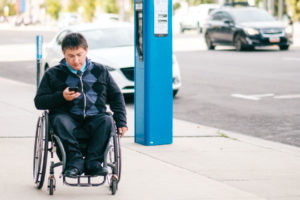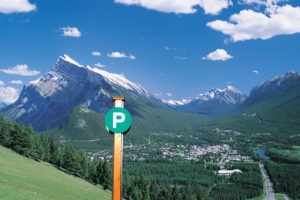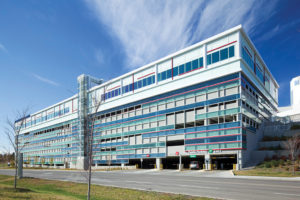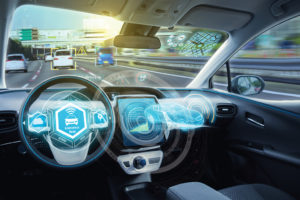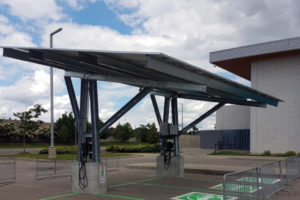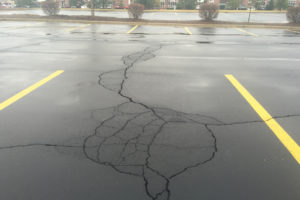By Renee Smith, JD MBA
Canada’s cities have long struggled with how to make their streets (and sidewalks and neighborhoods) more accessible to people with disabilities. There are many barriers to handicap access, including curbs bordering sidewalks, paucity of parking spaces designated solely for use by people with disabilities, and inaccessible buses and other forms of public transportation for people who don’t want to drive into the heart of the city. Add to that snow drifts, which are a common presence on our streets and sidewalks, and it’s easy to understand why it can be so difficult for people with disabilities to often struggle in our cities.
One area where cities sometimes fall short when it comes to accessibility is parking. That’s because it’s easy to fall into the trap of only addressing the most obvious accessibility issues, such as the size and location of parking spaces for people with disabilities. These are obviously important issues, but they only address part of the issue.
For many cities accessibility often ends at the curb cut. Parking planners tend to do a good job of making it easy to find appropriate parking and get safely out of vehicles and onto sidewalks. However, they don’t always give as much thought to their parking equipment, particularly meters and parking payment machines.
Impossible To Use
Not all parking equipment is designed with the needs of people with disabilities in mind, and older equipment can be particularly problematic. It’s often too tall or poorly designed for them to use, particularly those in wheelchairs. With the advent of pay-on-foot systems and smart meters, payment kiosks have become a common sight in cities. Unfortunately drivers with disabilities, particularly those in wheelchairs, sometimes can’t use these meters and kiosks because the credit card slots and cash receptacles in the equipment…
By Danielle Desjardins
One of the greatest environmental challenges our cities face today lies in mobility. The economic and social fabric of urban environments are closely intertwined with networks of vehicles and transportation systems that leave their mark: around one-quarter of global CO2 emissions come from the transportation of people and goods.
How should the parking industry adapt to a future in which major cities may deploy various strategies meant to diminish the number of private vehicles on their main thoroughfares, thus diminishing the need for parking spaces?
If you commuted to work by car in Montreal or Toronto in 2017, chances are you spent the equivalent of a normal work week being stuck in traffic. According to the Inrix Traffic Scorecard Rank1, commuters from these cities wasted respectively 50 and 47 hours being in a car immobilized by congestion.
As the population grows and more people move into urban areas, overwhelmingly choosing the suburbs over downtowns, traffic jams worsen and commuting to work becomes a never-ending nightmare. Hence a growing trend in major cities to implement various strategies and impose new rules to ease the gridlock and get people moving again.
For instance, many cities are banning cars from their centers: Oslo has pledged to do it by 2019, Madrid wants to do it in 2020, while cities like Rome, Dusseldorf and Stuttgart are planning to ban diesel cars in the near future.2 Other cities, like London, plan to create streets and street networks that encourage walking, cycling and public transport use in order to reduce car dependency3. Add this to other recent developments, like the proliferation of ride-sharing and car-sharing services and the advent of driverless cars getting people to work and returning home to park4, and you have the perfect storm for a decline in demand for parking garage services.
Embarking…
By Jessica Bates
A decade from now, many of us could be commuting to work in cars that drive themselves. For some, this sounds like science fiction; others can’t imagine willingly handing over the wheel to a computer. Nonetheless, driverless cars are almost certainly coming to a road near you, and they are likely to transform how we work and live in more ways than we can predict.
Driverless cars—also called autonomous cars or self-driving cars—are unmanned vehicles capable of sensing their environments and navigating without any human input. Early versions of these cars already exist and they are becoming more reliable and sophisticated every day. Commercial building owners and managers need to start thinking about how the autonomous vehicle revolution will affect their properties—from the loss of parking revenue to new development opportunities to the potential increase in tenant amenities.
THE TIPPING POINT
Cities already are starting to see significant shifts in commuter behavior with the rise of ride-sharing services, such as Uber and Lyft. More and more young people are entering the workforce without owning a car—or even having a driver’s license. J.F. Finn, III, AIA, principal and studio director for architecture and design firm Gensler, believes these behaviors will accelerate the rise in self-driving vehicles. “My nephews and nieces have no interest in car ownership—it doesn’t represent freedom and autonomy the way it has to previous generations,” Finn explains. “Many people are getting around just fine these days without the costs and inconveniences of owning their own car.”
Gensler’s research team predicts that, by 2021, ride-sharing services will become the dominant form of transportation, at least in urban centers. He calls this the “tipping point” where large numbers of autonomous vehicles become realistic. While today’s autonomous cars still require some human oversight, there is widespread optimism that fully autonomous cars will…
An interview with Shawn Skrine
By gtechna
In advance of this year’s Canadian Parking Association Conference held in Banff, Alberta, Banff’s Shawn Skrine sat down with gtechna, a Montreal-based eCitation and parking software company, for an interview that revealed some interesting points about what exactly makes a city “smart”.
Banff is a resort town located inside a national park, which means it has a small number of permanent residents and a seasonal population that fluctuates widely. Embracing cutting-edge parking technology has allowed Banff to easily accommodate the annual influx of tourist traffic; a great reminder that being a smart city is more about innovation than population!
Can you describe for us what parking is like in Banff?
We have five full time enforcement officers and in the summer, two to three seasonal officers. Our officers use two vehicles and two bikes to patrol roughly 2,000 spaces that we have downtown.
We have several surface lots, one four-story parking structure, and a good deal of street parking. All of our parking is time-limited, but free.
How does Banff’s high volume of tourists affect the parking situation?
To be honest with you, it’s more of the locals that were affected when we started implementing time-limit parking than it was the tourists, because tourists seem to look for signs.
We started time-limiting the parking to change behavior, which seems to have happened. Now after three years, there’s been about a 30% increase in time-limit compliance. The number of tickets issued for time-limit offences has been reduced and downtown parking turnover has improved, which is what we wanted.
What are the rules you use for time-limited parking?
It varies. Our zones range from 15-minute limits all the way to nine-hour limits. Streets usually have either two-hour or 15-minute limits, parking lots are all three hours, the parking structure has two-hour and eight-hour spaces, and there are…
By Danielle Desjardins
Thanks to the advancement of mobile computing, embattled city drivers cruising for a parking spot in our cities asphalt jungles are being presented with numerous new tools.
These tools come from a new wave of start-ups catering to parking services. These apps can book parking spaces before the driver leaves, pay for it online and even, in some instances, locate available parking spaces.
Take Parkifi, for instance. The Denver company has put together a mix of way-finding, data analytics and Internet of Things (IoT) technologies that uses hardware embedded in parking spots to alert drivers to open parking spaces (the feature is only available in Denver for now).1 Last spring the app added a way for users to pay for parking from their phone2.
Parkifi (https://www.parkifi.com/) presents itself to parking operators as an optimizer of their portfolios through a better exploitation of inventory utilization, prediction of future occupancy, optimization of pricing to match supply and demand, among other things.
What they offer parking operators is “efficient visibility and marketing tool by providing a better “parking experience for drivers, increasing satisfaction and repeat business”.
Or, as Parkman, another parking tools developer based in Finland, puts it: “customers are using phones to navigate to destinations. Make sure they navigate to your garage.”3
Finding available parking spaces in real-time is no magic act. For Parkopedia, a nine-year-old London company, it involves big data. The company relies on a trove of parking data it amassed since being established in 2007: starting with humans doing the job of surveying and taking pictures of parking garages, evolving to dynamic data sets provided via APIs from partners to GPS and traffic flow information from car manufacturers, accumulating along the way petabytes of parking information in the cloud. With this information, the predictive algorithms the Parkopedia team of four PhDs developed…
By Chelsea Webster
Let’s start the first mile of this journey by setting a goal for reading this article: learning what first mile and last mile means in relation to transportation, and finding ways for the parking industry to embrace (and maybe even capitalize) on this growing urban challenge.
The Rise of Public Transit
If you live in a city, you likely understand that public transit is an important part of city life. As more of the world’s population moves into cities, and cities aren’t able to accommodate the demand for individual cars and parking, transit will continue to grow in importance. There are lots of articles already touting that the personal vehicle is falling as king of transportation. As this process happens, it will be even more critical to make taking alternate methods of transportation as easy as possible.
If you’ve ever tried to take public transportation, you’re likely aware of a big setback inherent in any transit system: it doesn’t come right to your door.
So, if people aren’t willing to walk to the “nearest” transit stop, but still want to take the train or subway or express bus, how do they get to that transit stop? The process is called first mile (getting from your house or starting point to the transit stop) and last mile (getting from where transit lets you off to your actual destination) commuting.
We Love Our Cars
Thanks to the automobile revolution, we’ve seen the personal vehicle have a massive economic impact. Highways were built, automotive factories churned out vehicles of all sorts, and a whole new parking industry sprang up – all of which created hundreds of thousands of jobs in Canada and the US. With the ability for the average person to own a vehicle, people had the freedom to live and travel to places previously…
By Chris Davis, BSc, P.Eng., CEng, MICE, MIStructE, LEED® AP | Principal, RJC Engineers
The right parking plan is critical to the success of a parkade project – it strongly influences the budget and ultimately, the long term success for the owner. Determining an optimal plan requires careful, thoughtful design with experience and expertise in parking planning, but it also requires a fundamental understanding of how structural systems are integrated. The ideal solution provides a highly functional layout within an economical and easily constructed building.
No two buildings are ever the same. In order to meet the vast range of challenges that are presented throughout any given project, parking structure designers need to understand the objectives of their clients and the demands of the industry before beginning the design of a building. If they fully understand what the requirements and priorities are, they are better equipped to develop an optimal solution that can perform a range of functions – taking into account current and future uses.
Our industry is facing the impending probability that the presence and use of motor vehicles will soon be seeing major changes. With these changes, we will see the inevitable reduced demand for parking structures as we know them today. The parking industry, understandably, is starting to reconsider how parkades should be constructed for the future, with design life to structural codes of a minimum of 50 years. It is unlikely that many of the parkades we build today will be used in the same way in 50 years’ time. So, how do we make these purpose-built, one-function structures suitable for future use, when it’s so difficult to predict what they will need to do?
TRADITIONAL PARKING DESIGNS
Parking planning involves the efficient layout of traffic flow (entries, exits, circulation, etc.) and stalls within a given footprint. Developing the…
By Danielle Desjardins
We are on the brink of a revolution, a revolution that will profoundly affect society, change the way cities look and function and fundamentally transform how people and goods move.
It’s been dubbed the “driverless revolution” and it will be brought about by the advent of autonomous cars (AV), cars that drive themselves with little or no human intervention. In addition to their effect on modes of transport, AVs are poised to disrupt many industries: fast food, real estate, hotels, airlines — large industries that will have to shift their strategies in the wake of driverless cars.
The biggest disruption could be on parking. Among other innovations the revolution will bring, we will see AV fleets moving continuously between the various places they are needed, rendering the need for close and convenient parking spaces much less necessary.
Ready for the driverless revolution?
In the last issue, we discussed the potentially impending driverless revolution and the impact it could have on the parking industry1. In the envisioned driverless society, fully automated vehicles (AVs) would drop their passengers at their destination, go home to park or return in the transportation network while awaiting their next ride and the parking industry would be massively disrupted.
To some, the driverless revolution is already be upon us and our roads will be overtaken by robocars within the next five to ten years. Is this belief shared by the people involved in parking and are they getting ready for it?
In need of a crystal ball
Although all those interviewed for this article believe AVs will eventually rule our roads, some also believe that the revolution will be a long time coming.
“I don’t see it happening in my lifetime”, states Professor Michel Lejeune, who teaches sociology of technology at École Polytechnique in Montréal. The technology may be outstanding and almost…
By Jay Boychuk and Lisa Oelke, hb Solar Canada
Parking lots are assets for those that charge for the spaces within them, or need them to attract customers or even employees. They serve one main purpose, to provide a place to leave cars, whether it is for an hour, or a day. What if that asset could be turned into a multi-purpose piece of land that not only provides parking, but generates additional cashflow, and helps the environment? Parking lots can do a surprising thing, they can generate electricity, and not only that, its green energy. Introducing solar covered parking can do just that.
Why would a parking lot operator want to be a producer of green energy? Large cities can have a tremendous amount of asphalt covered surfaces, some above 40% of their land mass. Suburban areas don’t escape these large amounts of asphalt coverage either. A lot of that density is roadways, with surface parking lots significantly adding to the total as well. What does all this asphalt do to our environment if we just use it for parking cars?
When it comes to identifying the greatest challenge to meeting Green House Gas (GHG) reductions, transportation leads in Ontario as the single-largest emitting sector in the economy at 35%. In response to these statistics, the Ontario Government is encouraging drivers to switch to electric vehicles, (EV’s) by offering rebates of up to $14,000 with the purchase of an EV. Quebec and B.C. have similar statistics and have also offered incentives. The Electric Vehicle Chargers Ontario(EVCO) incentive serves to increase access to charging stations with funding to build a network of fast-charging EV stations in cities, along highways, at workplaces, apartments, condos, and public places across Ontario. These measures create demand for additional EV charging in locations where cars need
to park…
By Scott Sounart, PE
Parking lots play a vital role in the success of the buildings they serve, serving as a de-facto lobby and delivering the initial impression of the property. A run-down parking lot creates an unattractive and unwelcoming image that makes the entire complex seem less appealing and inviting. Perhaps more importantly, a derelict lot can also pose potentially hazardous conditions for visitors and employees and their vehicles. Not only can this undermine a business by making it’s location less attractive to potential customers, but it can also lead to costly legal liability if visitors or employees suffer personal injury or damaged vehicles.
Yet, in spite of the obvious hazards that can be caused by run-down or improperly maintained parking lots, many owners treat their lots as an afterthought. This is partly a perception problem. Many owners develop lots rather than a parkade because they mistakenly think that parking lots are essentially maintenance-free. They assume that they can just pave over an area of land, paint in stripes for spaces, and forget about it.
While it’s true that the typical lot requires less maintenance than a parkade, maintenance is required. Sure, there are no concrete ramps, floors, or support columns to care for, but a parking lot’s pavement undergoes a great deal of wear and tear every day from multi-ton vehicles, rain and snow, and even the rays of the sun. As such, it’s essential to have an assessment and maintenance plan to preserve the property’s aesthetics, ensure customer and tenant safety, and extend the service life of the pavement.
Pavements can be one of a commercial facility’s most expensive assets to maintain, but these costs can be minimized. There are seven primary types of asphalt distress, any one of which can require repair. The good news is that a pavement…


